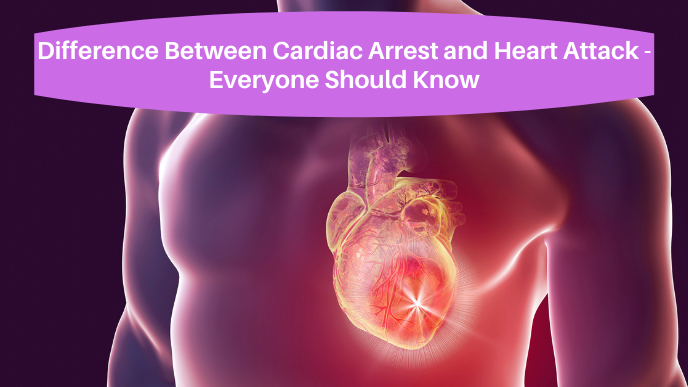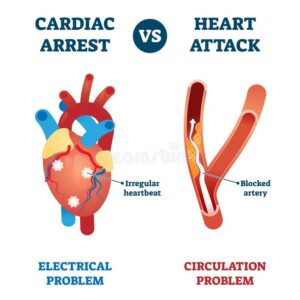

Cardiac Arrest, Heart Attack, or a Heart Failure – Is there a difference, or are these terminologies the same? In this article, let’s focus on the difference between Cardiac Arrest and Heart attack. Here are two real-life incidences:
Situation ‘A’
Navneet was 50 years old. One morning when he was walking out of the office cafeteria, he suddenly felt a pain at the center of his chest. Navneet thought it was just a heartburn and hence kept walking. As he stopped by his friend’s desk, he got very light-headed. His friend indicated that he looked gray and insisted on calling their emergency number. However, Navneet declined and chose to walk towards his cubicle through the long corridor. His legs felt rubbery as he approached his desk, and felt so disabled that he had to cling onto the cubicle walls to get some support and remain steady. Immediately thereafter, he was admitted to the emergency room and accordingly treated.
Situation ‘B’
Suraj was in his office talking to his team member when he started to get dizzy. He started to stumble around and then ran forward straight into a door frame. He fell on the floor straight. Suraj tried to speak, but he couldn’t. He had trouble breathing and started to unbutton his shirt as he felt suffocated. He was rushed to the hospital and given a round of CPR followed by other courses of treatment.
What can be derived from the above incidences?
Navneet, while in the hospital, discovered that there was 90% occlusion in his right coronary artery and had to get a stent placed to avoid further similar occurrences; whereas in Suraj’s case, his Left Anterior Descending artery (LAD) was 100% blocked and Right Coronary Artery (RCA) was about 80% blocked.
Nevertheless, symptom-wise, both the incidents mentioned above look similar but are very different. Situation ‘A’ is a case of Heart Attack, and Situation ‘B’ is a case of Sudden Cardiac Arrest (SCA).
People assume these to be similar medical conditions and often use the terms interchangeably. However, there is a significant difference between cardiac arrest and heart attack.
Medical science has made remarkable advancements and treating a heart attack or a cardiac arrest is much more possible, even non-surgically. Poona Preventive Cardiovascular Centre (PPCC) offers the most viable non-surgical treatment in Pune for heart diseases with the best and safest modern techniques. We solely believe in delivering scientifically-validated therapeutics for healthy and long-term wellbeing.
Since heart attack or cardiac arrest episodes can be fatal and traumatic, causing a high degree of damage to the heart anyway, it is always advisable that, if possible, you must opt for non-surgical treatment to go mild and easy on your heart.
To understand the major difference between Cardiac Arrest and Heart Attack, first, let’s get to know what these conditions are like?
What happens in a Heart attack?
Your heart beats 60 to 100 times a minute due to the oxygen that it carries. An instance of Heart attack can occur when a layer of plaque, a combination of cholesterol, fat, and other substances, blocks the oxygen-borne blood flow to the heart muscles.
What signs indicate a Heart Attack?
Usually, heart attack symptoms gradually begin developing a few hours, days, or weeks earlier and persist for some time. Also, the heart does not stop beating during a heart attack even after the blood supply is disrupted. Moreover, symptoms of heart attack can differ in men and women.
Few noticeable symptoms during a heart attack:
- Pressure, tightness, pain, squeezing, or aching sensations in your chest or arms, which may spread to your neck, jaw, or back
- Symptoms such as nausea, indigestion, heartburn, or abdominal pain may also be seen
- Breathing difficulty
- Cold sweat
- Fatigue
- Light-headedness or dizziness that may occur suddenly
Does your heart get damaged after a heart attack?
The heart is a very sturdy organ. So, after suffering an attack, even though some of it may get damaged, the other half keeps functioning. But, your heart may come down to a weakened condition that might need greater care after that.
What happens in a Cardiac Arrest?
Sudden Cardiac Arrest (SCA) may occur when there is a sudden loss of heart function. Due to irregular heartbeat (arrhythmia), the pumping action is disturbed, and the heart is unable to supply blood to the brain, lungs, and other parts of the body. Within a few seconds, the person falls unconscious, having no pulse. Untreated, such a condition worsens and leads to death.
It can happen to anyone at any time, although it most often happens in people already having some other health problem or who have a heart condition. The most common cause of a cardiac arrest is ventricular fibrillation, which happens when the electrical impulses tell your heart to beat.
Further SCA symptoms that show the difference between Cardiac Arrest and Heart Attack:
Sudden cardiac arrest symptoms are immediate and severe, including:
- Unexpected collapse
- No pulse detected
- No breathing.
- Unconsciousness
- Few other signs and symptoms may appear prior to a sudden cardiac arrest. These could include:
- Chest ache
- Weakness due to shortness of breath
- Palpitations are symptoms of a fast-beating, fluttering, or pounding heart. However, sudden cardiac arrest often occurs without warning.
Is there a link between SCA and Heart Attack?
Although medically, there is a wide difference between Cardiac Arrest and Heart Attack, these two conditions are interlinked. Basically, a heart attack may turn out to be the onset of a cardiac arrest as SCA may occur post a heart attack or while recovering from one. We can also say that heart attack may be a common cause of cardiac arrest.
Apart from a heart attack, thickened heart muscle, arrhythmias, ventricular fibrillation, and long Q-T syndrome can also be the reasons for a Sudden Cardiac Arrest.
Cardiac Arrest Vs Heart Attack – In a nutshell
Cardiac Arrest | Heart attack |
Sudden cardiac arrest is typically a medical emergency that can happen after the heart suddenly stops beating. | On the other hand, heart attack refers to a more serious condition in which a clogged artery interrupts blood from flowing to the heart. |
When a person’s heart stops pumping blood around their body, he stops breathing normally. In such a case, the person is said to be under cardiac arrest. | A heart attack is the cause of many cardiac arrests in adults. This is because a person experiencing a heart attack may develop a dangerous heart rhythm, resulting in cardiac arrest. |
What steps should you take during a heart attack or a cardiac arrest?
Although there is a difference between Cardiac Arrest and Heart Attack, the emergency care steps could be similar:
- Call the nearest medical emergency available
- Start CPR straight away
- Make sure there is room to lay down next to the person
- Place your hands on the middle of the person’s chest
- Push hard and fast in a downward motion at least 100 times.
- Then, continue to push hard and fast for another 100 compressions
- If you are on the floor, place your hands on the person’s shoulder to tilt their head back
- Continue the CPR process until professional emergency arrives.
We are proud to hone the fact that Poona Preventive Cardiovascular Center (PPCC) is the only clinic in Pune to be specialized in modern science techniques like Chelation Therapy, EECP, ESMR, and HBOT, ensuring effective non-surgical treatment in Pune for heart problems. We are completely dedicated to efficient management of Cardiovascular diseases and heart disorders to avoid risky surgeries. With tailored programs comprising lifestyle modification, diet management, and nutritional supplements, we make sure that our patients are healthy and hearty for a long time.


